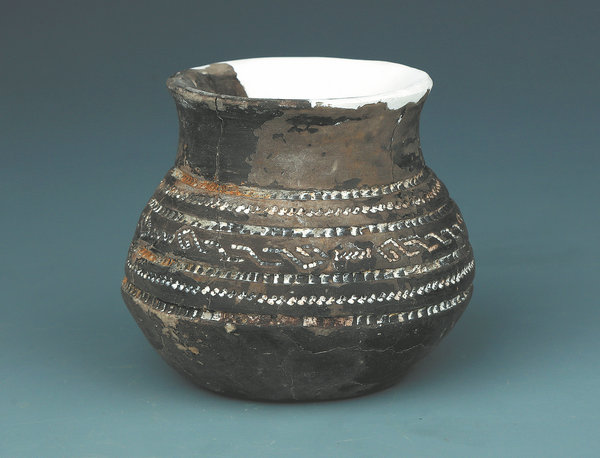Environment forced changes thousands of years ago, findings suggest

A jade artifactunearthed from the site dating back 7,200 to 6,900 years. [Photo provided to China Daily]
Some pits, on the other hand, are paved with mat and clamshell.
Researchers have also discovered house foundations at the site, most of which are made of reeds and wood. The number four foundation, for instance, remains 11 meters long from east to west and 7.7 meters wide.
It was constructed using wood and reeds as raw materials, with the main structure located on the northern side. A wooden fence is located on the outermost southwestern and southern sides, forming a semicircular enclosure. A reed fence or wall is located inside the wooden fence, with a remaining length of 5 meters and a width of over 1 meter, says Gan.
Reed architecture was common in the early stage of the site, but in the later period, wooden structures seemed to have developed to a higher level, he adds.
Among various artifacts unearthed, Gan says the bone relics are especially well-made and rich in number and type.
"We have found more than 1,600 bone artifacts like spade-shaped farm tools, boot-like artifacts, arrowheads, hair clasps, daggers, awls and needles. They are exquisitely crafted and entirely polished. In addition to the finished products, some blanks and semifinished pieces were also unearthed," says Gan.
The plant and animal relics help people gain an understanding of ancient people's subsistence. Researchers have identified remains or seeds of water chestnuts, rice, Gorgon fruit and wild soybean.
"The rice remains unearthed at the site are identified as cultivated rice. ... Therefore, the early settlers' food acquisition included at least agricultural production and gathering of wild edible plants, with rice farming being an important component of their livelihood," says Gan.

A pottery jar unearthed from the site dating back 7,200 to 6,900 years. [Photo provided to China Daily]
The animal remains include domesticated pig and wild animals. This shows that although domestication of livestock had already begun, hunting wild animals and fishing remained the main ways of acquiring meat, he adds.
"The site is well-preserved, which is rare to see. Since it is located in the Lixiahe area, a low-lying area vulnerable to the transgressions of sea, we didn't expect such an old site to be found there," says Zhang Chi, an archaeology professor at Peking University.
From the discoveries of the site and environmental analysis, Gan tries to tell a story of ancient people adapting to the environment several thousand years ago.
"About 8,500 years ago, the site area was 10 meters lower than now. Then, with global climate and environmental changes, including fluctuations in sea levels and the deposition of sediment from rivers, the site area underwent multiple changes between land and sea. About 7,200 years ago, the site area became a coastal wetland, a habitable place with abundant wildlife and plant resources," says Gan.
Therefore, people chose to settle there, engaging in rice cultivation, hunting and fruit gathering, and thrived for hundreds of years. However, with subsequent transgressions of the sea, the area was no longer suitable for habitation. People then were forced to migrate to other places, he adds.
In the late Neolithic period, the area became habitable again and gave rise to a number of sites. Today, the area is located over 100 kilometers away from the coast of the Yellow Sea.
"The rise and fall of the site and the development of prehistoric cultures in the area vividly demonstrate the relationship between environmental changes and human adaptability, providing valuable insights for addressing today's global climate change," says Gan.
